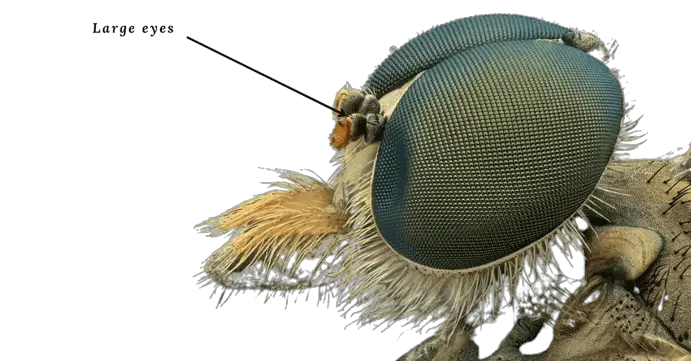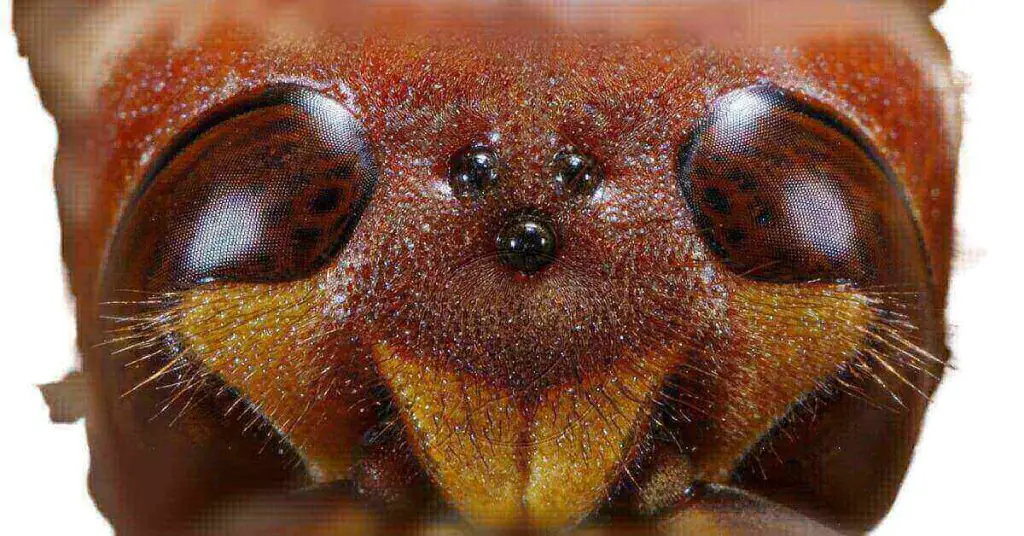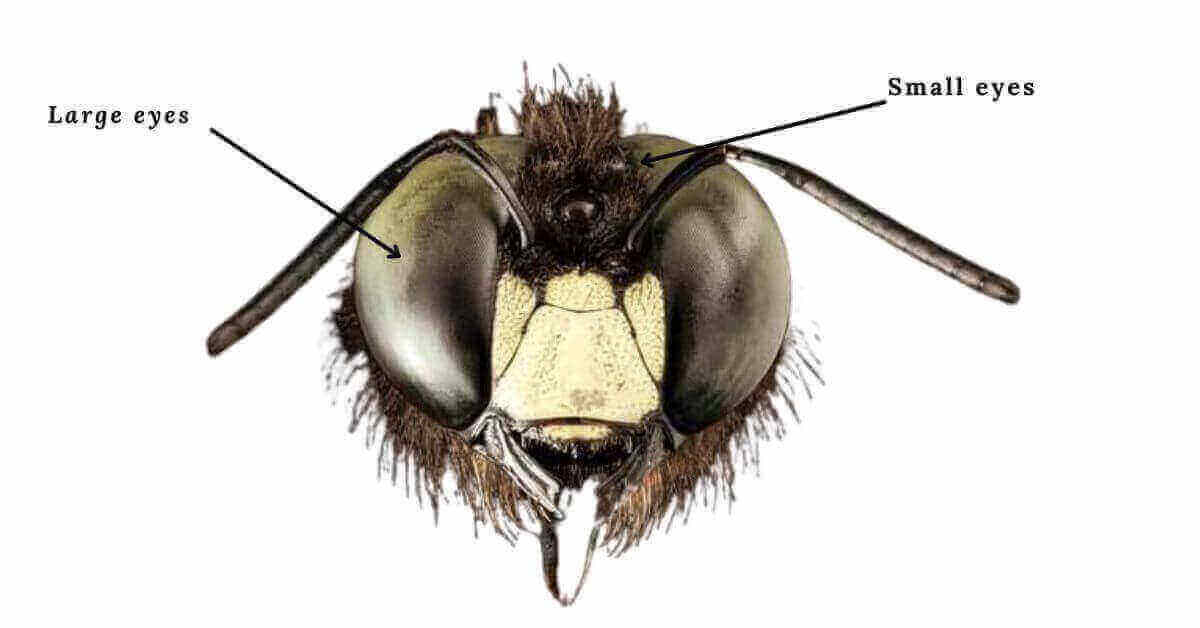Bee have total 5 eyes, with two sets (compound & Ocelli) large & small eyes. Bees have compound eyes, which are made of many smaller lenses arranged in hexagonal patterns. Each of these smaller lenses forms its image, which the bee’s brain combines into a panoramic view of its surroundings. Compound eyes are highly sensitive to movement and are ideal for detecting flowers and other potential food sources and navigation.
One of the unique features of a bee’s eyes is its ability to see ultraviolet light. This allows the bee to detect ultraviolet markings on flowers that are invisible to the human eye. These markings serve as a guide to the location of nectar and pollen, helping the bee to find food more efficiently.
Types of bees Eyes
1) Compound or large eyes
The two compound eyes are located on either side of the bee’s head and are highly sensitive to light. They are used to detect movement and to help the bee navigate. The lenses in these eyes are arranged in a hexagonal pattern, which gives the bee a wide field of vision, allowing them to see in all directions except directly behind them.

Both these two eyes play an essential role in detecting movement. Bees’ eyes detect movement only in 1/1300 nano seconds, but our eyes detect only 1/50 in nano seconds. They also help to find food, & keep away from danger.
2) Ocelli or small eyes
The three simple eyes, also known as ocelli, are located on the top of the bee’s head in a triangular formation. These eyes are used to detect light intensity and help the bee determine the position of the sun. They are particularly important for bees that forage for food, as they use the sun as a reference point to help them find their way back to the hive.

Bee eyes colour
Bees’ eyes have different colours, not black they have blue, green & silver coloured eyes. Bees’ eyes are primarily hairy.
Why do bees have 5 eyes?
Because two sets of eyes perform different functions, not only for colour & shapes, bees sense if a predator is following them.
Hair on bees eyes
Two large eyes are hairy. Hair grows only from these two eyes to detect wind. So bees can travel in the air. Sometimes bees use the sunlight to navigate.
What colours can bees see?
Some colours like green, violet and blue are the flowers bees visit most, so bees like these colours.
How do bees see the world?
Bees and humans are trichromatic. Both have three photoreceptors. Humans have green, blue and green, but bees have green, blue and ultraviolet which help bees to see everywhere. Ultraviolet lights are different in humans and bees.
What colours do bees hate?
Bees don’t like black colour or dark. That’s why bees stay in their hive at night. Bee eyes hate the colour red.
Can bees see white?
It is very difficult to say that bees can see white colour. But some colours which attract the bees are blue and yellow-green.
Do all bees have five eyes?
Yes, all kinds of bees have 5 eyes with two sets. Compound & ocelli.
8 Resanable Facts on Bees Eyes.
- Bee’s eyes consist of thousands of individual units called ommatidia.
- Each ommatidium has its lens and photoreceptor cells, allowing the bee to have a wide field of vision and detect movement and color.
- Ultraviolet light allows them to see floral patterns and detect nectar in invisible flowers to the human eye.
- Navigation patterns help bees to locate food sources and identify potential mates.
- The bee’s eyes are positioned on the sides of their head, providing them with a panoramic view and the ability to see in all directions except directly behind them.
- Sensitive property helps bees to polarize light, which helps them determine the sun’s position even on cloudy days.
- The bee’s eyes are also used in communication, with the positioning and movement of their eyes sending signals to other bees in the colony.
- Honeybees have specialized cells in their eyes that are sensitive to the movement of shadows.
How Many Eyes does a Queen bee have?
Conversely, a queen bee, despite its elevated status within the hive, possesses the same type of compound eyes as other bees in the colony. The number of ommatidia in a queen bee’s eyes, like with wasps, can also vary but is generally within a similar range. Queen bees, however, rely more on their other senses, such as their acute sense of smell and their ability to detect pheromones, to fulfill their reproductive and leadership roles within the colony.
How many Eyes does a Wasps have?
A wasp possesses compound eyes, which are crucial for its survival and navigation. These compound eyes are composed of thousands of individual lenses, known as ommatidia. These lenses work together to provide the wasp with a mosaic-like view of its surroundings, allowing it to detect movement, patterns, and colors. The exact number of ommatidia in a wasp’s compound eyes can vary among species, but it typically ranges from a few thousand to over 10,000. This intricate visual system equips wasps with exceptional sight, helping them locate prey, avoid predators, and find suitable nesting sites.
Related Articles:
- How many Bees are in the world?
- Do Bees Hibernate? Why do Bees Hibernate?
- How Many Beehives Per Acre.How much Honey per Hive.
Can bees see at night?
Of the 25000 species of bees in the world, not all bees see at night or in the dark, but some species of bees see at night because these species’ eye sensitivity is 50% higher than that species which can not see in the dark. These bees can travel at night. Wasps bees have more sensitivity than other bees. They have a faster-seeing ability, which can help them to defend their nests at night against predators.
Can bees see in the dark?
Not all, but some species of bees can see little in the dark. But bees move towards the light when they see the light at night.
How much can bees see?
A maximum of 350 to 650 bees can see. Red is the only colour that bees cannot see. Bees easily differ in dark & light.
Summary
The eyes of a bee are essential to its survival. They help the bee to find food, navigate, and maintain its internal clock. By providing the bee with detailed information about its surroundings, its eyes help to ensure its ability to survive and thrive.




